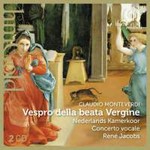
MARBECKS COLLECTABLE: Monteverdi: Vespro della beata Vergine (1610) Deluxe Edition
 $45.00
Low Stock
add to cart
$45.00
Low Stock
add to cart
CLAUDIO MONTEVERDI
MARBECKS COLLECTABLE: Monteverdi: Vespro della beata Vergine (1610) Deluxe Edition
Maria Cristina Kiehr, Barbara Borden, Andreas Scholl, John Bowen / Concerto Vocale, Nederlands Kamerkoor & Nederlands CO, René Jacobs
[ Harmonia Mundi / 2 CD ]
Release Date: Wednesday 1 June 2005
Should this item be out of stock at the time of your order, we would expect to be able to supply it to you within 2 - 4 weeks.
Original recording released in 1996
"Rene Jacobs presents here what is in many ways an old-fashioned view of the 1610 Vespers. Everything is performed at the same pitch, in fact A=440; he follows the sequence of movements in the original prints except in exchanging the "Ave maris stella" and the "Sancta Maria"; he has a substantial chorus to contrast with his soloists, sometimes changing over between phrases; his orchestra is larger than most; and the only added music is plainsong antiphons performed both before and after each psalm. Some of those decisions are defensible, but it does mean that the main competition for his new recording is in versions over 20 years old - Jurgens and Gardiner.
Jacobs's novelty is in thinking that when Monteverdi writes for two equal voices with the same clef and matching music it sounds better with singers who sound utterly different from one another. Since several of the performers here are unknown to me, I would prefer not to specify exactly what happens (they are not individually credited in the notes, though the alto Andreas Scholl seems to sing a lot of the soprano lines, and many of the tenor lines sound distinctly baritone, presumably Victor Torres), but those listening to "Pulchra es", "Duo seraphim" or "Audi coelum" will be able to hear and judge for themselves. One should encourage original and well-considered artistic decisions; but this one I find rather distracting.
The acoustic ambience (again not specified) is nice and rich but suffers from a nasty echo, so notes occasionally jump back at you and a fair amount of the best detail is lost. Even so, it seems that Jacobs sometimes takes tempos that put the faster notes way beyond even the skilled Netherlands Chamber Choir (particularly in "Laetatus sum" and "Nisi Dominus"). The instrumentalists are excellent, with a thick and warm continuo group as well as perhaps the most secure cornetto players I have heard (though it is odd that they embellish like mad while the violins keep doggedly to the written notes).
Jacobs approaches the work with courage, a wide range of tempos and a vivid imagination - features that characterize so much of his finest musicianship. Many sections positively glow. But it remains hard to see how this challenges the grand old recordings of the years around 1970.' (Gramophone)